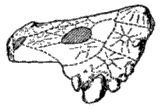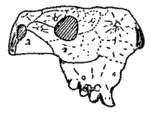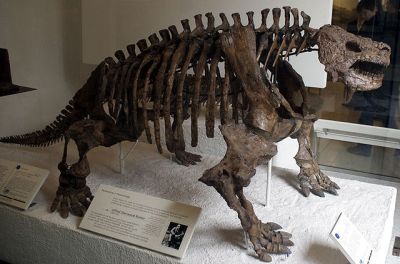|
|
Anapsida |
| The Vertebrates |
Pareiasauridae (3) |
Anapsida: Pareiasauridae (3)
Pareiasaurinae
Taxa on This Page
- Pareiasaurus X
- Scutosaurus X
- Shihtienfenia X
Descriptions
Shihtienfenia permica Young and Yeh 1963
Synonym: Honania complicidentata Young, 1979, Huanghesaurus liuliensis Gao, 1983, Shansisaurus xuecunensis Cheng 1980, Tsiyania simplicidentata Young, 1979
Stratigraphic range: Shihtienfeng series / "pareiasaur fauna" / Shiqianfeng Formation of Shansi province and Shihezi Formation of Henan (Late Capitanian/Early Wuchiapingian age) China
Phylogeny: Velosauria : Embrithosaurus + (Deltavjatia + ((Pareiasaurus + (Scutosaurus + (Elginia + Pumiliopareiasauria)) + (Pareiasuchus + *)))
Characters: "rounded expansion on the anterior margin of the scapula blade, near the dorsal end; and the acromion process is a smoothly contoured, semicircular flange" - Lee 1997
Comments: The skull of this pareiasaur is unknown. It is known originally from a number of isolated vertebrae, jaws, and limb-bones and an incomplete skeleton, all from a single locality (Shiqianfeng Formation at Baode, Shansi). Shihtienfenia is unusual because of the presence of 6, rather than the usual 4, sacral vertebrae, and may belong in a separate subfamily, although Oskar Kuhn includes it under the Pareiasaurines in his monograph (Kuhn 1969). As with the Pareiasaurines the upper margin of the ilium is flat. No dicynodonts are found in association, so these animals obviously lived in a separate environment. MAK000124
Shansisaurus xuecunensis, from the Shihezi Formation of Henan, differs only in possession of a more robust humerus, which is not enough to justify taxonomy separation; Huanghesaurus liuliensis known from a lowre jaw and partial skeleton would be another synonym. (Lucas 2001). Honania complicidentata and Tsiyania simplicidentata Young, 1979, also from this locality, are based on isolated teeth and probably invalid taxa, or synonyms of S. permica. Lee 1997 refers to S. xuecunensis as a metaspecies lacking the autapomorphies of Shihtienfenia. Tsuji & Müller 2009 seem to consider it a valid taxon for cladistic analysis, and like Lee 1997 place the two Chinese species close to Pareiasuchus.
In all instances biostratigraphic correlation is difficult because of the very fragmentary nature of associated fauna (a single dorsal vertebra attributed to the amphibian Bystrowiana, a possible gorgonopsian, and several "procynosuchid" teeth. Bystrowianids and procynosuchids would imply a very late date (Changhsingian), but this material is so fragmentary and to be non-diagnosable. Lucas 2001 originally considered the fauna to be of dinocephalian (=Tapinocephalus zone - Capitanian) age, but later Lucas 2006 reassessed this as correlated with his Steilkransian land vertebrate age (=Cistecephalus zone) on the basis of the Shihtienfenia being equivalent to Pareiasaurus, Pareiasuchus, and Scutosaurus. Cladistic analyses however ( Lee 1997, Jalil & Janvier 2005, Tsuji & Müller 2009) shows that Shihtienfenia (coded as two species) is more basal than all three of those taxa, but more derived than Deltavjatia. It is likely therefore to be either a contemporary of, or slightly later than Deltavjatia, which would put it at Late Capitanian or Early Wuchiapingian age MAK120330
Pareiasaurus Watson 1914
Synonyms: Pareiasuchus, Propappus
Stratigraphic range and localities: Early Tropidostoma to Middle Dicynodon zone (Ward et al 2005, supplem. info, range data; ), (previously referred to as Endothiodon to Daptocephalus zones) Lower Beaufort Beds, Karoo basin, (latest Wuchiapingian to Middle Changhsingian age), Lower Beaufort Beds, Karoo basin, South Africa; Luangwa valley Zambia; Ruhuhuh valley, Tanzania. (Early Wuchiapingian to Early Changhsingian age)
Phylogeny: Velosauria : Embrithosaurus + (Deltavjatia + ((Pareiasaurus + (Scutosaurus + (Elginia + Pumiliopareiasauria)) + (Shihtienfenia + * )))
Length: about 2.5 meters long
Weight: about 600 kg
 comments: This genus includes a number of large Pareiasaurs. The skull is broad and the snout short. There are 4 sacral vertebrae. The phalangeal count of the fore-foot is 2,3,3,3,2. The armour is well developed, with several rows of heavy scutes. There are 14 pairs of low, broad-crowned teeth, each with 9 to 13 or more cusps (depending on the species). MAK000124
comments: This genus includes a number of large Pareiasaurs. The skull is broad and the snout short. There are 4 sacral vertebrae. The phalangeal count of the fore-foot is 2,3,3,3,2. The armour is well developed, with several rows of heavy scutes. There are 14 pairs of low, broad-crowned teeth, each with 9 to 13 or more cusps (depending on the species). MAK000124
[2] Most species have since been moved to Pareiasuchus, which is now considered more derived than the Chinese Shansisaurus and Shihtienfenia it shares the clade with (note that these two latter taxa are considered synonyms by Lucas 2001). Lee 1997 suggests the self-explanatory name Pareiasuchidae for this clade, although an -inae suffix would be less coinfusing as -idae is the linnaean family rank suffix. Because of the incomplete knowledge of the Chinese pareiasaur(s), only a single unambiguous synapomorphy is currently known to diagnose the group: $ Extremely long scapula blade. However, further finds might reveal that other traits, currently interpreted as autapomorphies. Alternatively, this character may simply be the result of convergence - e.g. the need for increased shoulder muscle attachment due to feeding habits, intraspecific behaviour or environmental factors. Moreover, since a very long scapula is a feature found not only in Shihtienfenia but typical for pareiasaurs as a whole (Lucas 2001 p.80, consider for example this this photo of Deltavjatia) the validity of this synapomorphy may be questioned. Another thing that should be considered is paleogeography. Were pareiasaurs uniform across pangea, or were they evolving separately in geographically endemic clades? For now we find it more parsimonious to consider that Deltavjatia, Shihtienfenia, primitive Pareiasaurus (Pareiasuchus, perhaps a subgenus) and advanced Pareiasaurus as part of a single evolutionary (and hence paraphyletic) continuum. MAK120330
 |
Pareiasaurus nasicornis (Haughton and Boonstra 1929)
Synonym: Pareiasuchus nasicornis Haughton & Boonstra, 1929 is more commonly used in literature today, to avoid a paraphyletic Pareiasaurus
Stratigraphic range: Endothiodon Zone, Karoo basin, South Africa
Characters: large descending cheek flanges project backwards, gving the the skull a delta-shape in dorsal view; ridge bearing internal trochanter extends to the preaxial tibial facet (convergence with Bradysaurus baini ). - Lee 1997
Comments: This early form is one of the first representatives of the genus. It was originally included under the genus Pareiasuchus. The snout is heavily armoured, and bears a horn-like boss. The teeth are equipped with 11 (or possibly 13 or 15) cusps. This is a large animal; the skull is about 50 cm in length. This species might be ancestral to Pareiasaurus peringueyi. MAK000124
Pareiasaurus peringueyi (Haughton and Boonstra 1929)
Synonyms: Pareiasuchus peringueyi Broom & Haughton, 1913 more commonly used in literature today, to avoid a paraphyletic Pareiasaurus; Pareiasaurus pulcher Broom, 1935 is an old synonym no longer current
Stratigraphic range: Cistecephalus Zone, Karoo basin, South Africa
Characters: lateral flange of the exoccipital forms a distinct, dorsally-oriented crest along the posterior margin of the paroccipital process; small median tubercle on the internal surface of the mandible, directly above the symphyseal 'hook'; angular boss a large, blunt knob - Lee 1997
Comments: [1] This species was the type species for Pareiasuchus. It is represented by a nearly complete skeleton from the Zak River, South Africa. It is a medium-sized animal, the skull being 36 cm long. It is distinguished especially by the large quadrato-jugal region inclined far outwards and forwards so that its lower border makes an angle of about 120o with the maxillary border; this cheek bears large bony bosses. There are at least 13 pairs of teeth in the upper jaw, each with 13 or possibly 15 cusps (Zittel & Eastman 1932 p.243)
[2] Scutosaurus from the Dvina river, northern Russia was originally included under Pareiasuchus (Hartmann-Weinberg 1933) but is a more advanced genus
Pareiasaurus serridens Owen 1876
Synonyms: Anthodon gregoryi Broom, 1930, Anthodon nesemanni Broom, 1940, Brachypareia rogersi (Broom, 1912), Bradysaurus rogersi (Broom, 1912), Pareiasaurus minor Seeley, 1892, Pareiasaurus omocratus (Seeley, 1888), Pareiasaurus pinnatus Olson & Broom, 1937, Pareiasaurus rubidgei Broom, 1940, Propappus omocratus Seeley, 1888, Propappus serridens (Owen, 1876), Propappus rogersi Broom, 1912,
Stratigraphic range: Daptocephalus Zone, Karoo basin, South Africa
Characters: cranial sculpturing consists of a reticulate network of fine pits and grooves but there is no boss on the centre of each element; dorsal flange on the anterior margin of the proximal end of the paroccipital process - Lee 1997
Comments: This late species is the type species for Pareiasaurus, and represents the culmination of this lineage. The armour is well developed. There are 14 pairs of teeth, each with 9 to 11 cusps. The short deep skull is about 40 cm in length. Note the extended quadrato-jugal region (cheek bones). MAK000124
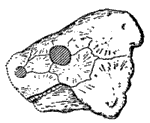 |
As befits such a popular and charismatic secies the list of synonyms is out of control, although it may be that some of these represent chronospecies, others would be growth stages, individual variation, etc. Pareiasaurus omocratus (Seeley 1888), from either the Endothiodon or Cistecephalus Zone, was the type species for Propappus. Only fragments of the skull are known. The back thickly covered with large, slightly sculptured, bony scutes. There does not appear to be ventral (belly) armour (Zittel & Eastman 1932 p.243) . This species is now considered a synonym of Pareiasaurus serridens. Anthodon gregoryi Broom 1930 (right) from the Middle? Cistecephalus zone, Karoo was attributed to the advanced genus Anthodon, but would be a large species for that genus, known from an incomplete skull almost 30 cm wide. The teeth only have have 8 cusps each. It is now also considered a synonym of Pareiasaurus serridens MAK000124 120329
Scutosaurus karpinskii (Amalitzky, 1922)
synonyms: Pareiasaurus karpinskii (or karpinskyi (see note)) Amalitzky, 1922, Pareiasuchus elegans Amalitzky, 1922, Pareiasuchus horridus Amalitzky, 1922, Pareiasuchus tuberculatus Amalitzky, 1922, Scutosaurus itilensis Ivachneko & Lebedev, 1987 and possibly also Proelginia permiana Hartmann-Weinberg, 1937 and hence also Scutosaurus permianus (Hartmann-Weinberg, 1937), but see note
Stratigraphic range: classically, upper part of Zone IV (Tatarian stage), of Sokolki, Malaya Severnaya Dvina River, Arkhangelsk Region, northern European Russia (mathematical com), but this is a widespread index fossil found widely throughout late Wuchiapingian to Middle Changhsingian age assemblages of the Perm region of Russia and thereabouts. Earlier occurances (early to mid Wuchiapingian) are attributed to Proelginia permiana by Russian biostratigraphers, this may be either a synonym of S. karpinskii or a chronospecies (S. permianus) that evolves into it, given the large span of time involved, we have tentatively gone with the latter option
Phylogeny: Velosauria :Deltavjatia + (Shihtienfenia + Pareiasuchus) + (Pareiasaurus + ((Elginia + Pumiliopareiasauria) + *)))
Size: length 2 to 3 meters, mature (3 meter) specimens would have a live weight of at least a tonne
Characters: small median boss on the basioccipital between the basal tubera, crowns of the teeth on upper jaw point slightly outwards, radiating ridges covering the skull are very coarse. - Lee 1997, p. 210
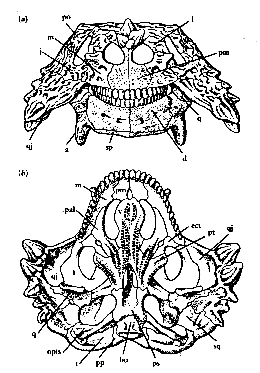 |
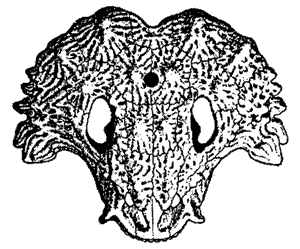
Left: Scutosaurus skull, front and palatal view from Carroll, 1988, p.205above: Scutosaurus skull, top (dorsal) view Kuhn, 1969, p.79 |
The skull (left) is very broad, flat, and strongly sculptured, and bears bony protuberances in the jugal (cheek) and rear regions. As with some species of Pareiasaurus, with which it is clearly related, the quadrato-jugal or cheekbones extend outwards and forwards, makings an angle of about 120o with the maxillary border.
The skull shown on the left is about 50 cm wide. MAK000124
The post-cranial skeleton is well known. There are 6 cervical, 13 dorsal, 5 (or 4?) sacral vertebrae, and only a few tail vertebrae
Comments: [1] This very large pareiasaur occurs at a later time than Deltavjatia vjatkensis. Originally known from several skeletons found together in a flood channel sand deposit, it is a common and widespread index taxon. It is an advanced form with upright limb posture, this being an adaptation for supporting the weight of the body (Cox et al 1988) although it has also been interpreted as semi-aquatic (e.g. Golubev 2000 p.S221) (and hence presumably sprawling). The skin is heavily armoured with osteoderms.
[2] Stratigraphically earlier specimens are consistantly referred to as Proelginia permiana and used by Russian paleontologists in biozonation, which implies it is a morphologically distinct species (Golubev 2000, Tverdokhlebov et al 2005, Sennikov & Golubev 2006, Newell et al 2010). Western paleontologists consider it a synonym of S. karpinskii. We have tentatively considered these as the chronospecies Scutosaurus permianus (Hartmann-Weinberg, 1937) and Scutosaurus karpinskii respectively
[3] due to problems of transliteration from Russian cyrillic, the species name is variously spelt with one or two "i"'s. it is occaisonally also spelt "yi"; according to MSY Lee (2001), the "karpinskyi" variant was inadvertently published prematurely by Watson in 1917 when the full description was delayed by war and the death of Amalitzky, but "karpinskii " should be retained; We have adopted this latter spelling as the correct one
[4] With Scutosaurus and other pareiasaurs, spikes and horns developing on the snout and from the lower jaw only develop with age, and may have been used in mating displays or other intraspecific behaviour (Lambert et al 2001 p.73)
[5] The genus name, "Shield Reptile" refers to the large plates of armor scattered across its body. (Wikipedia)
[6] Perhaps the most popular of the pareiasaurs, Scutosaurus features both in the Walking with Monsters speculative documentary series and thePrimeval sci fi TV series. In Walking with Monsters it is shown as a social animal that migrated in groups. Certainly pareiasaurs did seem to have been gregarious and social creatures (as indicated by large numbers found together, often mired in swamps in standing position), their status as migratory animals is purely speculative In paleo art and dramatisations Scutosaurus is depicted as being preyed upon by large gorgonopsids. While it is not impossible that animals such as the lion- or bear-sized Inostrancevia could have taken on these ox-sized animals, they would have obviously preferred to pick off juveniles or sick or oilder individuals, rather than challenge an Scutosaurus, which was both heavily armoured and the largest and strongest animal in its environment. MAK120402
Links: Scutosaurus karpinski web page (mathematical com); Paleobiology database; Scutosaurus at Palaeocritti; Scutosaurus - Prehistoric Life; Scutosaurus - Daily Fossil, Scutosaurus - all about reptiles; Deviant art, Wikipedia; Scutosaurus - Wikimedia Commons (photos and art); and many many more links (many short pages with the same art, photos, and text content)
 comments: This genus includes a number of large Pareiasaurs. The skull is broad and the snout short. There are 4 sacral vertebrae. The phalangeal count of the fore-foot is 2,3,3,3,2. The armour is well developed, with several rows of heavy scutes. There are 14 pairs of low, broad-crowned teeth, each with 9 to 13 or more cusps (depending on the species). MAK000124
comments: This genus includes a number of large Pareiasaurs. The skull is broad and the snout short. There are 4 sacral vertebrae. The phalangeal count of the fore-foot is 2,3,3,3,2. The armour is well developed, with several rows of heavy scutes. There are 14 pairs of low, broad-crowned teeth, each with 9 to 13 or more cusps (depending on the species). MAK000124
